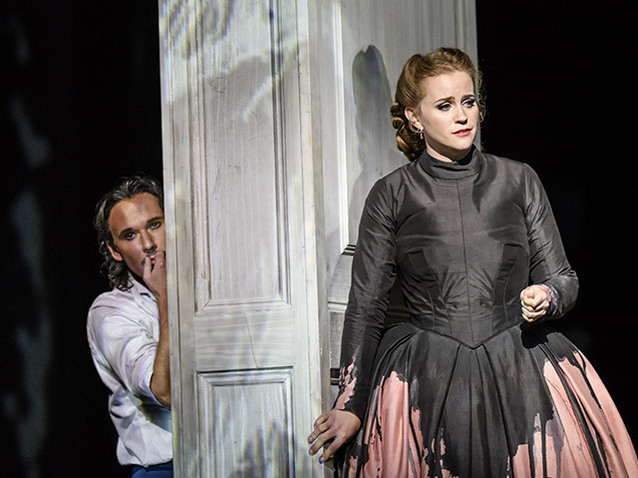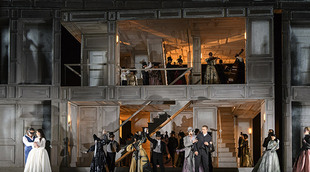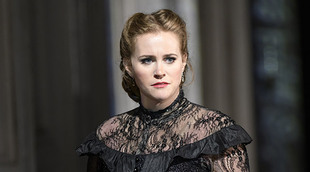 © (c) Bill Cooper
© (c) Bill Cooper
Don Giovanni of 1787 is one of three operas that Mozart wrote with the librettist Lorenzo Da Ponte (the others being Le nozze di Figaro and Così fan tutte). It tells of the eponymous hero, or rather antihero, who effortlessly conquers thousands of women. Although in the process he makes many enemies, the ladies he has cheated have a habit of coming back for more or trying to save him, and in the end he is responsible for his own downfall. When the ghost of the Commendatore who he murdered comes to dinner and invites him to repent, the Don instead chooses to live by the life he has led and consequently descends to hell.
Kasper Holten’s version, which represents a co-production with Houston Grand Opera, Israeli Opera and Gran Teatre del Liceu, was first seen at the Royal Opera House in 2014 when he was its Director of Opera. Revived for the second time by Amy Lane, it has always been an intelligent production that shows a strong eye for detail and renders the social hierarchies quite subtly. For example, the Don frequently occupies a higher stage level and hence sings down to his servant Leporello, while the simple chairs at the wedding of the lowly Zerlina and Masetto contrast with the grander house behind.

Don Giovanni © ROH / Bill Cooper
The production’s concept, however, is somewhat dictated by Es Devlin’s revolving set, which consists of a cube-shaped house with two levels that are connected by staircases. Upon this Luke Halls’ video projections appear continuously throughout, and play a large part in telling the story. When the Commendatore is murdered blood appears to drip over the entire set, all of Don Giovanni’s former women are scrawled across the walls during the Overture and so-called ‘catalogue aria’, while the names of individual characters such as Donna Elvira appear on doors as if suggesting that each is destined to behave as they do. Don Giovanni also sings of how he plans to have fun with women as a mass of names and staircases swirl around him, thus revealing how he expects the world to revolve around him in order to provide pleasure.
Anja Vang Kragh’s costumes also reflect what we see in the set, as in Act II the dresses of Donna Anna and Donna Elvira reveal ‘splattered’ or other patterned effects. All of these details are important in a production that penetrates the psychology of the drama so that, for example, the Don often appears silently before the female principals in their dreams (or solo arias). ‘Faceless’ figures also roam the set representing the ‘ghosts’ of women whom the Don has wronged and deserted, and who are now left as shadows of their former themselves.
The difficulty that this production has always faced, however, is that the sheer size of the set can swamp the performers and hence affect the dynamism. For example, in Act I Donna Elvira repeatedly bursts on to disrupt the Don’s plans, but when she has to do so by ascending a staircase or standing on a different level to the other protagonists, it undermines the immediacy of the action and hence the joke. Similarly in Act II when ‘Don Giovanni’ (actually Leporello in disguise) is captured by five of his mounting enemies, it hardly feels as if his life is genuinely threatened because three of them can do no more than look down from the level above.

Rachel Willis Sorensen © ROH Bill Cooper
Nevertheless, if the vastness of the set has in the past affected the ability of the performers to assert their characters, this second revival sees the problem reduced to a minimum because the cast is so strong. The class shows with both Mariusz Kwiecień as Don Giovanni, reprising his role from the original production, and Ildebrando D’Arcangelo as Leporello. Kwiecień has the baritone and presence to project the Don’s unique brand of sinister charisma, while D’Arcangelo reveals an extremely firm bass-baritone as he shows the servant to be disgusted, yet also perversely intrigued, by his master’s behaviour.
Sir Willard White is luxury casting as the Commendatore, while Pavol Breslik and Anatoli Sivko reveal immensely pleasing tenor and bass-baritone voices as Don Ottavio and Masetto respectively. Besides Kwiecień and D’Arcangelo, however, it is the trio of women who really steal the show with Rachel Willis-Sørensen’s Donna Anna revealing an intense, focused and beautifully intriguing soprano, Hrachuhi Bassenz’s Donna Elvira combining sumptuousness with focus and anguish, and Chen Reiss’s soprano being so well shaped that she offers far more than simply a sweet voice as Zerlina. In spite of a few difficulties with a production that is still not perfect, the sheer strength of the cast, combined with Marc Minkowski’s sensitive and astutely observed conducting, make this the best rendering of this Don Giovanni yet.
By Sam Smith
Don Giovanni | 29 June – 17 July 2018 | Royal Opera House, Covent Garden
the 05 of July, 2018 | Print

Comments